
My flight to Athens was routine enough and, as both Italy and Greece are Schengen countries, there were no immigration formalities. The Olympics package I'd purchased from Cosport included airport transfers and I quickly found the person holding a red Cosport sign with my name. I then got handed off to a couple of other people and, eventually, put in a taxi to my hotel, the Achilleas. I filled in the registration form for the hotel and got my key and some instructions from the Cosport representative there. Specifically, she informed me that the hotel uses the system that requires you to put your room key into a slot to turn the electricity on. She also pointed out that Greek elevator doors don't open automatically. Apparently, a lot of people get confused by this and just stand there staring blankly, rather than pulling the door open. I should also mention that you don't put toilet paper down the drain in Greece. Instead, there's a small wastepaper bin provided. Some people seem to get freaked out by this, but it's not uncommon in other parts of the world, too.
In the room, there was a backpack with a few odds and ends (a cap, a little kit with sunscreen and the like, etc.) and, most importantly, the Olympic spectator guide, which explained all the transportation and had venue maps. I glanced through all of this, unpacked, and then set out for an early evening stroll and dinner. By the way, I'd say the Achilleas was just okay. The room was clean and large and the location was fine, but it was fairly noisy, with doors being slammed at more or less all hours.
In the morning, my first order of business was tackling onward transportation. I had no trouble finding the Larissa Railroad Station (easily reached by the metro) and bought a ticket to Thessaloniki. It was apparently not possible to buy the ticket on to Sofia, probably because the Greek railroad hasn't discovered things like computers yet. Incidentally, there is allegedly bus service to Bulgaria (from the Peloponnese Station), too, but nobody knows anything about it. As I prefer sightseeing to chasing down bus information, there was nothing to do but wait until I was in Thessaloniki.
I should mention that the metro system itself provides a certain amount of sightseeing, as its excavation uncovered ruins, which are displayed at several of the stations. For example, the Syntagma Square station has an entire glass wall, allowing a view of a major archaeological site, with other display cases showing items found at the site. But the real obligatory site is, of course, the Acropolis.

There is supposed to be an EUR 12 admission charge. But, when I arrived at the entrance on the south side, a woman handed me a brochure and a ticket that said "entry free." I didn't exactly understand why, but I didn't object. Coming in that way, one arrives first at the Theatre of Dionysus. That's followed by a temple to Asklepios, the god of health, and, eventually, the Odeion of Herodes Atticus, which has been restored for use as a theatre. All the time, one is walking uphill and, as it was intensely hot (105 Fahrenheit), I was glad I'd brought along two bottles of water. It seems that the word "Acropolis" is Greek for "no shade." Eventually, one reaches another gate where it looks like you should be paying admission, but nobody asked for any money. There is also, by the way, a water fountain at that gate, with blessedly cold water.
Fortunately, there was a breeze at the top. Despite crowds and some scaffolding, seeing the Parthenon was a thrill.

However, I actually preferred the Erechtheion, a temple to both Athena and Poseidon. It has no scaffolding, no crowds, and some lovely caryatids.
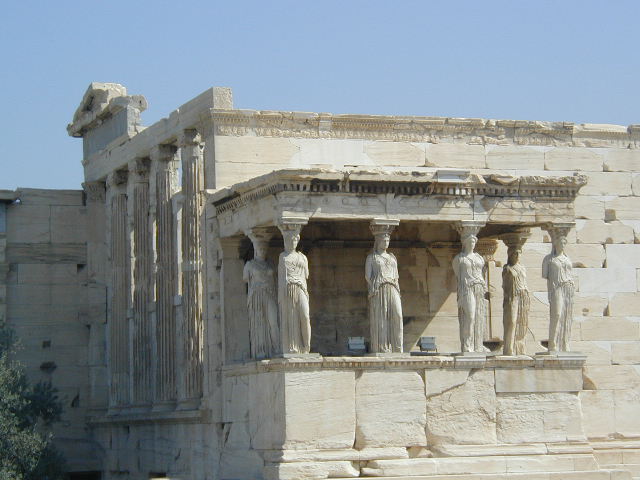
At any rate, I wandered the top, enjoying both the temples and the views over the entire city. The best view is the one of the Agora, including the well preserved Temple of Hephaestus.
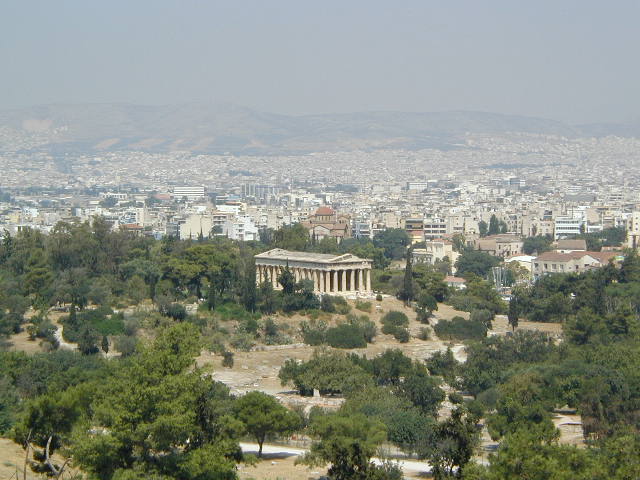
I should note two possibly useful things to know about the Acropolis. First, the stones are worn down enough to be a bit slippery, so wearing good walking shoes is wise. I saw a few people who had obviously not anticipated this. Secondly, the Olympics brought an amazing infrastructure improvement. There is now an elevator to the top, which can carry one wheelchair user and an attendant. Since this just opened, it's not mentioned in any guidebooks yet. It's not an issue for me, but it's so rare that an archaeological site is accessible, I thought it worth mentioning.
I continued on to the Agora, which also supposedly has an admissions charge. There wasn't anywhere obvious to buy a ticket, so maybe I happened to stumble on "free ruins" day. The Agora was the ancient marketplace of Athens and was probably a reasonably pleasant public space. Nowadays, there are a number of things to see, starting with a Byzantine church full of faded frescoes. I'm not positive, but this may have been built over the ruins of the Nymphaion, if I'm interpreting the guidebook correctly. The biggest structure is the reconstructed Stoa of Attalas, which houses the museum and lots of headless statues. There are a few bigger statues which mark the Odeon of Agrippa. But the aforementioned Temple of Hephaestus is the really dramatic site. There's an interesting frieze there, depicting the labors of Hercules, but one can't get close enough to get a decent photograph of it.
Sightseeing is all well and good, but cafe sitting is also important, so I stopped for a late lunch. Food in Greece is much cheaper than in Italy, but is also less to my taste. I found myself eating a lot of salad, on the grounds that I got to add only as much olive oil as I wanted, instead of the excessive quantities that tended to mar the cooked food. And they do have tasty tomatoes. The real horror is what passes for coffee. I expected that I'd be able to get that nicely muddy beverage that we tend to call Turkish coffee, but the thing that's all the rage in Greece these days is something called frappe, which consists of instant coffee, milk and sugar. I hope I never get quite desperate enough for caffeine to find that acceptable.
My real purpose in the trip was going to the Olympics. Tickets to the opening ceremonies were way too pricy, so I watched those on television from the comfort of my hotel room. The only sports related event I could conceive of paying a thousand or so bucks for a ticket to is game seven of a World Series between the Red Sox and the Cubs. Hey, it could happen. I did, however, have tickets to four events. The first was men's gymnastics preliminaries. This was up at the Athens Olympic Athletic Complex, better known as OAKA.
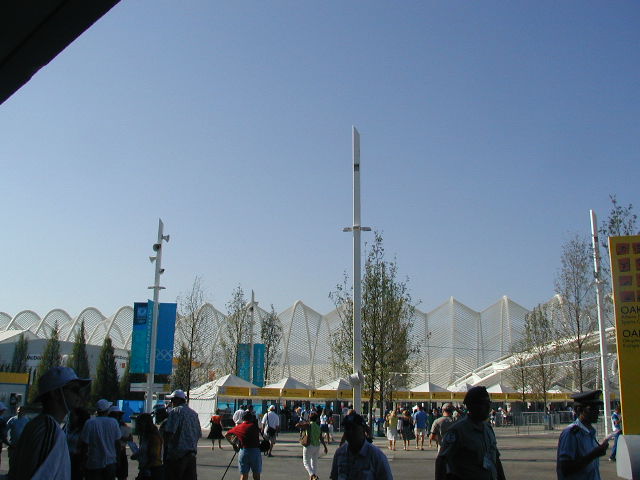
This was easily reached by the metro and I should probably mention that I thought it was a nice touch that all the public transportation was free to people going to and from Olympic venues. That is, if they checked tickets (which they rarely do), your Olympic ticket was all you needed. The security was simple (basically, just like an airport) and had almost no wait time. That meant I had time to shop in the Olympic super store before going to the indoor hall where gymnastics was held. It's rather remarkable what a wide range of official items were on offer. I bought a t-shirt for myself and various small odds and ends for other people. I'll also note that there's a large food court and an entertainment stage, sponsored by Samsung, which alternated between live performers and filmed bits of competition (mostly beach volleyball from what I saw). The individual venues all play music before (and between) competitions, with a surprisingly eclectic mix. I should also mention that announcements were made in Greek, French, and English. Surprisingly, I found I could recognize the Greek numbers. Perhaps that isn't so surprising, given that they do turn up in mathematical prefixes, but it's knowledge I hadn't conciously realized I had.
As for the gymnastics competition itself, preliminaries didn't draw much of a crowd so it was pretty empty. I happened to be sitting next to the family of one of the Canadian gymnasts so I got to hear a bit of informed commentary. The biggest difference between seeing things live and seeing them on television is that everything is happening at once and it's sometimes hard to decide where to look. It was also interesting to see the way things are set up for the media, e.g. the camera that slides on a track to film the vaults. I went to the effort of figuring out how to turn off the flash on my digital camera in hopes of getting some decent photos, but the gymnasts just move too fast and all my attempts at action shots were a mere blur.
The other event I went to at OAKA was diving. Specifically, it was the synchronized diving finals - women's 3 meter springboard and men's 10 meter platform. I have to admit that I hadn't actually been aware there was such a thing as synchronized diving, but it turns out that this was only introduced in Sydney. Two judges evaluate each diver and five judges evaluate the synchronization. There are two mandatory dives of 2.0 difficulty, followed by three where the divers can choose their degree of difficulty. It was fairly obvious that the Chinese divers dominate the sport. I had no hope of photos since, not only did the divers move fast, but the venue was fairly full and I had a seat at the far end. That did mean I had a great location for the medal ceremony, though.
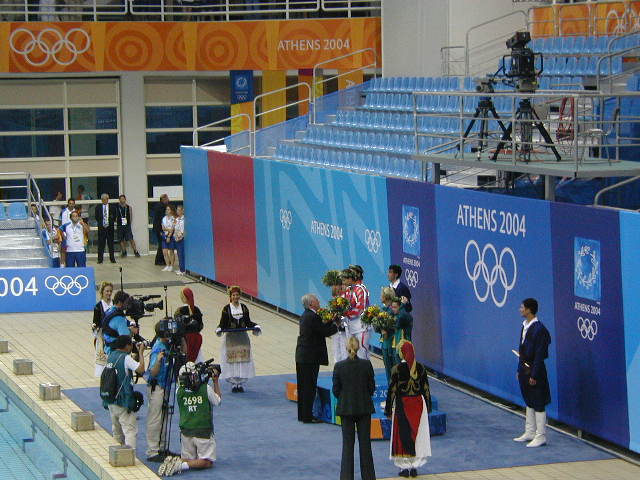
The most complicated venue to get to was the Markopoulo Equestrian Center. This required first getting to the airport, followed by a bus from the airport park and ride. The catch was that, while the metro runs directly to the airport, only about one train in six goes the whole way. There was a lot of waiting involved and it took nearly two hours to get out there. Even worse, only one of the dozen or so food counters had coffee and I had a ten minute wait to get actual hot brewed coffee. The next glitch involved getting a program. Actually, the programs were widely available, but they'd neglected to print the names of the horses and riders. They did eventually get start lists, but it took a bit of effort to obtain one.
The actual event I went to was the dressage phase of the three day event. I've watched this on television, but I can't say I'm knowledgeable enough to appreciate a lot of it. I could tell some competitors were very good and others were struggling, but the subtleties in the middle eluded me. One nice aspect is that the horses have to stop at various points, making photos feasible.
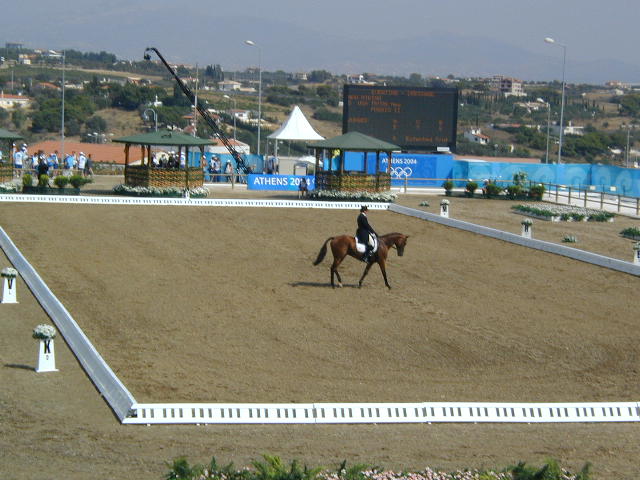
All in all, it went rather slowly, with over thirty competitors and breaks after every six. The really horsey types, who are seriously into the sport, can sit through all this, but I have to admit that after a while it all looked the same to me. I gave up in favor of going back to town and strolling around the Plaka (a pedestrianized shopping district).
The final event I went to was men's foil fencing. I normally prefer watching epee, but the schedule for that didn't work for me. Even the foil was extremely exciting and surprisingly well attended, with very loud and enthusiastic fans from France, Italy, Germany, and Austria. I chatted with a young woman from Australia, who had never been to a fencing match before, explaining the sport to her as best I could. I was successful enough to get her to cheer for my favorite - Andrea Casserta from Italy, who ended up winning the bronze.
By the way, the fencing was at the Hellenikon Sports Complex, which is on the site of the former airport. Getting there involved taking the new tram, which was interesting largely for the views along the coast during much of the trip. Back in the central city, I had time for a stroll around Parliament, watching the changing of the guard (who dress in a rather distinctive manner and march in an even more unusual one) and stroll through the National Gardens, before getting the train to Thessaloniki. The ride was a little over five hours and was just okay in terms of comfort. I attempted to buy a ticket on to Sofia right when we arrived, but the only window that sells international tickets was already closed for the night. So I just walked to my hotel (the Vergenia, which is just a few blocks from the station) and collapsed.
In the morning, I was finally able to buy a ticket to Sofia. I opted for a sleeper, as that is only EUR 26, versus the EUR 15 to sit up all night. (By contrast, the ticket from Athens to Thessaloniki was EUR 39, of which EUR 25 was the supplement for the faster "intercity" service.) Having accomplished my important business, I set out to see the sights of Thessaloniki. Once one gets past the rather dowdy commercial area near the train station and some surprisingly busy shopping areas, the ruins start to appear. I soon reached the Paradise baths, allegedly the first Ottoman bathhouse in Thessaloniki. It's pretty much intact in form, but the faded frescoes inside are seriously in need of restoration.
The obligatory thing to visit in Thessaloniki is the White Tower. Walking to it, I passed through a pleasant market area and along a cafe-lined coastal strip. The tower is pretty much the national symbol of Macedonia (pronounced Makedonia, by the way, and still a matter of international dispute as to just what it should include) and has something to do with fortifications against the Ottoman Turks. An interesting bit of trivia is that it was painted white by a Jewish prisoner who gained his freedom by performing that chore.
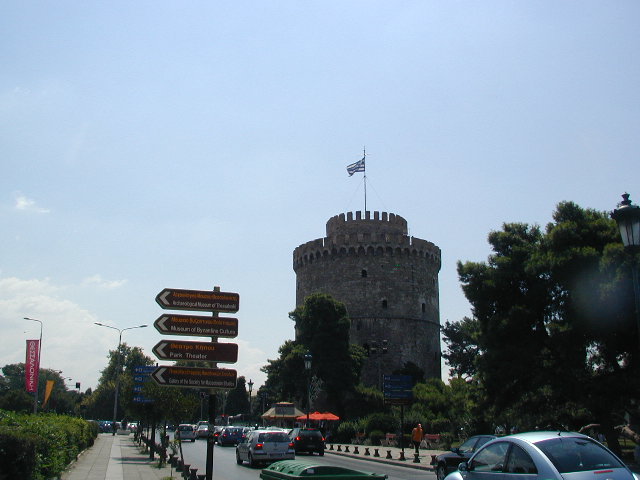
The tower is seven stories tall and one walks to the top up a spiral ramp, with low steps here and there. The turret has sweeping views over the sea and the city - but it is not really a very attractive city. The second level has a museum which explains the history of the tower (in Greek and English) and displays various photos of people celebrating events there. All in all, the tower is probably not worth the EUR 2 admission, but one shouldn't balk at perceived value in a city's most famous sight.
My further strolling took me past a state of Phillip of Macedon and on to a huge church, which turned out to be the Rotonda. This is famous for its mosaics of early eastern Christian saints. Next to the Rotonda, there's a huge arch engraved with friezes of some triumphal event of the Roman era.
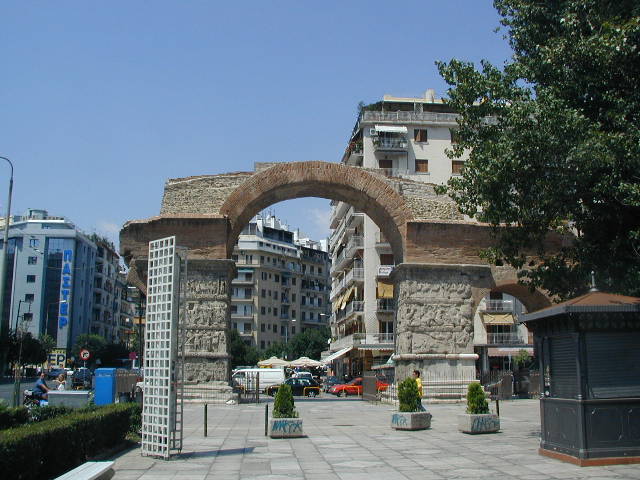
From there it was just a short stroll to Navarinou Square. The appearance of various Byzantine ruins amongst tall blocky Soviet-like modern architecture and flashy upscale shops and cafes is rather startling. I kept feeling tempted to turn to someone and say (to quote my father), "Look, they're building another ruin!"
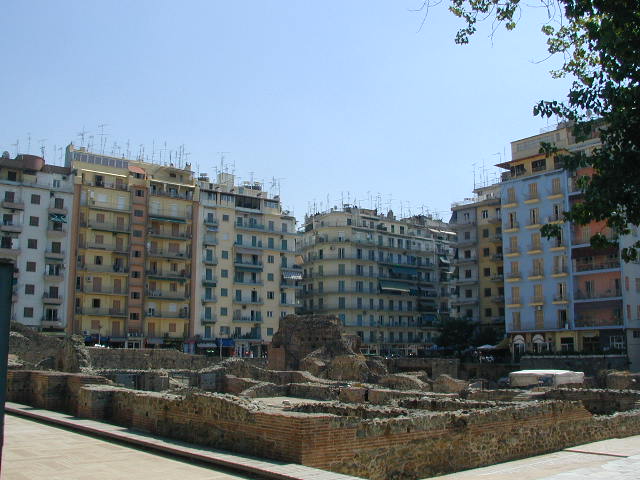
The cafes provide their own pleasures, including an excellent local lemonade that actually tastes strongly of lemons. Sitting in a cafe also, alas, requires one to wave off African immigrants peddling pirated CDs, but they are fortunately not very persistent. The other major cafe center of Thessaloniki is Aristotelous Square. This has great potential as a public space, but fails miserably. The cafes are full, but the park benches are empty and the statue of Aristotle presides over little more than a parking lot for motorbikes. Incidentally, the cafes on the north side of the square are fashionable and bustling, while those on the south side are empty. It wasn't apparent to me why, but I opted for the crowds and was rewarded with reasonable ice cream.
I attempted to find a few museums, a task not made any easier by the only tourist map I'd been able to obtain, which provided addresses but not even grid numbers to help in finding those addresses. I never managed to find the Jewish Museum and only located the Museum of Byzantine Musical Instruments as it was closing. I killed the rest of my time until the train with a leisurely dinner and a visit to an internet cafe. All in all, I'd say Thessaloniki is fine for a transit stopover, but I'd be hard pressed to recommend it for a longer visit.
On to Bulgaria | Back to Italy | Back to Index
Xenophilia Home
last updated 6 September 2004